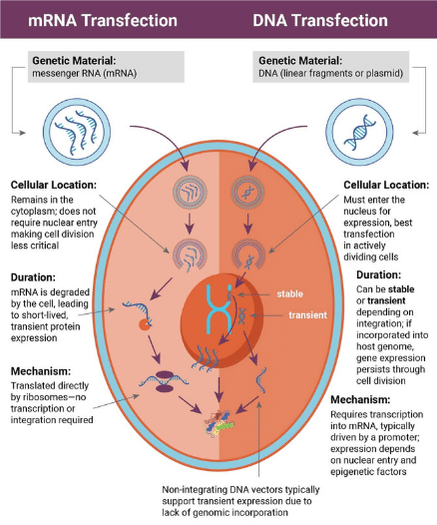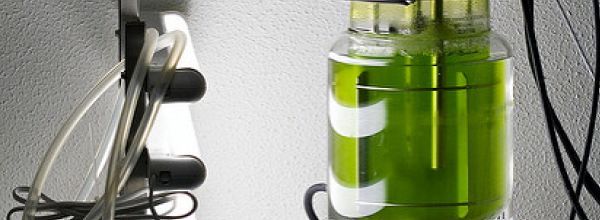Transfection lets you manipulate gene expression on demand, whether you’re silencing transcripts, driving protein expression, or probing promoter activity. Today’s methods make it possible to introduce DNA or mRNA into a wide variety of eukaryotic cells, from immortalized lines to stem cells.
As research shifts toward more physiologically relevant models, the need for fast, efficient transfection methods continues to grow (1).
This article explores the trade-offs between mRNA vs DNA transient transfection when it comes to efficiency. It explores how mRNA offers a flexible alternative to plasmid DNA, providing rapid, promoter-independent expression with no risk of genomic integration, and why it’s increasingly favored for hard-to-transfect cells and time-sensitive workflows (2).
Transient vs. Stable Transfection: Understanding the Foundation
Transfection is a core technique in molecular biology used to introduce foreign nucleic acids—such as DNA, RNA, or small RNAs like siRNA, shRNA, and miRNA—into eukaryotic cells. We use this technique to manipulate gene expression and study cellular processes, disease mechanisms, and therapeutic strategies (1).
Depending on your goal, you can use transfection to knock down transcripts, express proteins, or probe promoter activity in systems from immortalized lines to stem cells (1).
Transfection strategies can be classified into two main categories:
- Stable transfection integrates foreign DNA into the host’s nuclear genome or maintains an episomal vector in the host’s nucleus, known as an extra-chromosomal element. This enables long-term expression, even as cells divide, as it may then be constitutively expressed (1).
- Transient transfection does not integrate into the host genome and is typically performed using plasmids or oligonucleotides. In this case, foreign nucleic acids (DNA or RNA) express briefly before being degraded or diluted out by cell replication (1).
While stable transfection is ideal for protein production or creating engineered lines, transient transfection is often preferred for fast, reversible experiments, such as pathway analysis, reporter studies, or functional screening (1). Transient transfection is especially valuable for short-term studies like pathway mapping or immune response profiling, because you can express genes without permanently changing the genome.
If you’re reading this, you’ve likely chosen transient expression already. Now the question is: which format will serve you better?
DNA vs. mRNA Transient Transfection: Mechanisms and Implications
While both DNA and mRNA transfection deliver genetic material into eukaryotic cells, they rely on different cellular processes—differences that impact efficiency, timing, and compatibility with certain cell types (1).
- DNA transfection typically involves plasmids or linear fragments that must traverse both the plasma membrane and the nuclear envelope. In dividing cells, the nuclear envelope breaks down during mitosis, enabling more efficient delivery. In contrast, non-dividing cells pose a challenge because DNA entry into the nucleus is limited. Once inside, gene expression is initiated from a promoter region, making expression levels heavily dependent on promoter strength, chromatin accessibility and epigenetic context. Expression may be transient or, if integrated into the genome, stable.
- mRNA transfection, on the other hand, bypasses the nucleus entirely. Synthetic or in vitro-transcribed mRNA is delivered directly to the cytoplasm, where it is translated into protein by ribosomes. No transcription is required, and there’s no need for promoter sequences or chromatin accessibility. Because expression is independent of the cell cycle, mRNA is ideal for non-dividing cells, including neurons, stem cells and other primary lines (1,2). mRNA delivery also offers more uniform expression and fine-tuned control: protein levels correlate directly with the amount of mRNA introduced (2).
mRNA’s non-integrating, transient nature makes it safer for therapeutic and gene editing applications—such as CRISPR or mRNA-based vaccines—while DNA is better suited for stable line creation, high-yield production, or complex multi-gene constructs (1).

The table below summarizes the core differences between mRNA vs DNA Transient Transfection (1,2):
Plasmid DNA | mRNA | |
Cell cycle dependence | Requires nuclear entry; best in dividing cells | Works in dividing and non-dividing cells |
Onset of expression | 12–24 hours | 2–6 hours |
Duration | Days to weeks; can generate stable lines | Hours to days; transient expression |
Expression uniformity | Often mosaic | More even across cells |
Titratability | Indirect (promoter strength) | Direct (mRNA dose) |
Handling | Stable and easy to propagate | RNase-sensitive, requires careful storage |
Integration risk | Possible | None |
Note: While mRNA expression is transient, it can support permanent changes in genome-editing workflows such as CRISPR (1,2).
Why Use mRNA? Top Advantages
1. Speed and Control
mRNA gives you rapid protein expression, often within 2–6 hours. Because there is no transcription step, you can titrate mRNA based on the amount of RNA delivered, giving you control over protein output (2).
2. Precision and Safety
mRNA does not integrate into the genome, making it ideal if you want a temporary change. This is particularly advantageous in gene editing workflows, where limiting the duration of nuclease expression helps minimize off-target effects (2).
3. Flexibility Across Cell Types
mRNA is ideal for primary cells, non-dividing cells, and hard-to-transfect models where nuclear delivery is inefficient (2).
4. Ready-to-Use Format
You can skip steps like generating stable lines or packaging into viral vectors (2).
5. In Vivo Compatibility
RNA transfection methods, particularly those involving lipid-based systems, have been successfully used in vivo to deliver genetic material in animal studies (2).
Challenges and Limitations of mRNA Transfection
Despite its advantages, mRNA transfection comes with some caveats:
- Short Expression Window: mRNA expression typically lasts hours to a few days, limiting use in long-term studies (1,2).
- Handling Sensitivity: mRNA is susceptible to RNase degradation, so you’ll need strict RNase-free practices and careful storage at –80 °C to keep it intact (2).
- Lower Protein Yield per Cell: Because expression is proportional to the amount of mRNA delivered, you may get a lower yield than with DNA in some contexts (1,2).
- Production and Cost: Unlike plasmid DNA, which can be easily propagated in bacteria and stored for repeated use, mRNA must be synthesized or purchased for each experiment—often at a higher initial cost (2).
Still, for many researchers, time savings, safety profile, and success in difficult cells make mRNA well worth it (2).
When to Use mRNA vs. DNA (1,2)
Use Case | Choose mRNA if… | Use DNA if… |
Cell type | Working with primary or non-dividing cells | Using immortalized, dividing lines |
Speed | You need results in hours | You can wait 24+ hours |
Expression Duration | You want short, controllable bursts | You need sustained or stable expression |
Workflow | You want ready-to-use solutions without genome integration | You have plasmids and protocols ready |
Safety | Avoiding genome integration is critical | Stable integration is desired |
A good rule of thumb: Start by asking, “What cells am I working with, and what do I need the expression to do?”
Practical Tips for mRNA Transfection
Handling Tips
- Keep it RNase-free: Use gloves, RNase-free tubes and filter tips (2).
- Optimize storage: Aliquot and store mRNA at –80°C. Avoid freeze-thaw cycles (2).
Optimization Tips
- Choose quality-modified mRNA: Look for transcripts with 5′ Cap 1, poly(A) tails, and chemically modified bases (e.g., pseudouridine, 5-methylcytidine) to enhance stability and translation efficiency (2).
- Titrate your dose: Start with a range of mRNA concentrations to find optimal expression (2).
- Use mRNA-specific reagents: For best results, use a reagent specifically optimized for mRNA delivery, such as the ViaScript™ mRNA Transfection Reagent from Promega (2).
Get Going with mRNA Transfection
If you are switching from DNA to mRNA, or trying to optimize a new assay, you could get a head start by using a commercial solution such as the ViaScript® mRNA Transfection Reagent, by Promega. Using a commercial product means you get a reliable, ready-to-use solution that makes transient expression easier to implement.
The ViaScript® mRNA Transfection Reagent is optimized to offer high efficiency and low toxicity, even in cell lines that are typically hard to work with. You can use it with in vitro-transcribed RNA, to get fast, tunable expression with a compact assay window and uniform transgene distribution across your cell population.
Final Thoughts
mRNA transfection is a practical, flexible approach suitable for applications where speed, safety, and precise expression control matter most.
With precise control, broad compatibility, and faster timelines, mRNA will open doors for you to experimental designs that DNA alone can’t easily fulfill (1,2).
With optimized solutions like ViaScript™ mRNA Transfection Reagent, Promega helps researchers bring the power of mRNA into their lab—safely, reliably, and effectively.
References
- Chong, Z. X., Yeap, S. K., & Ho, W. Y. (2021). Transfection types, methods and strategies: a technical review. PeerJ, 9. https://doi.org/10.7717/peerj.11165
- Transfection Guide | Overview of Transfection Methods | Promega. (n.d.). Www.promega.com. https://www.promega.com/resources/guides/cell-biology/transfection/ ?utm_source=bitesizebio&utm_medium=externalblog&utm_campaign=ms-2025-livecell







